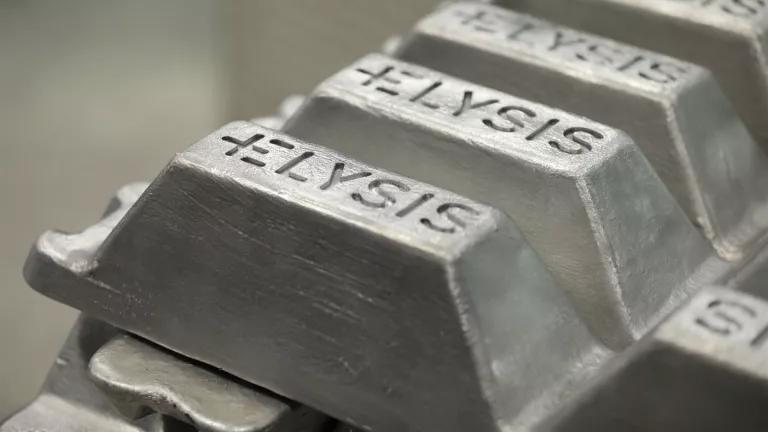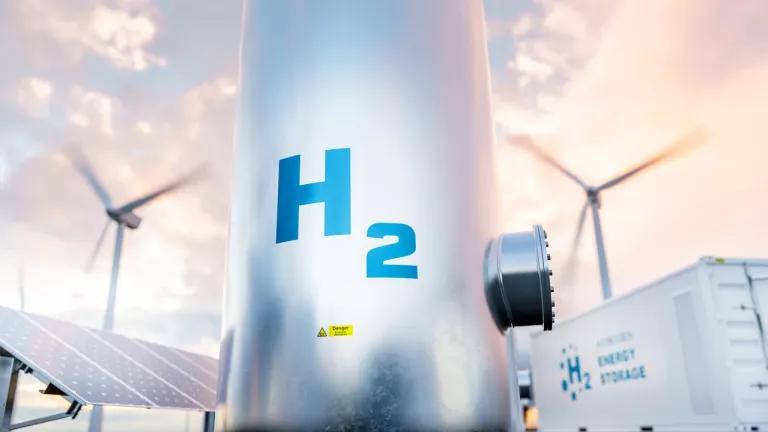The Role of Inert Anodes in Aluminum Decarbonization
Inert anodes can play a key role in eliminating emissions from primary aluminum production.

Ingots of Elysis aluminum, produced by an innovative new process that uses inert anodes
Apple
After steel, aluminum is the second-most-used metal in the world. Aluminum is incredibly lightweight, can be easily shaped, is highly conductive of electricity, and is corrosion resistant. While synonymous with such everyday staples as soda cans and foil wrap, it is not just for consumer goods: It is also critical for the transition to a clean energy economy as a key component of grid infrastructure, solar installations, wind turbine components, and electric vehicles. At the same time, aluminum production is a significant contributor to climate change. The aluminum industry is responsible for 2 percent of global greenhouse gas (GHG) emissions, and demand for the material is growing significantly. Without intervention, a necessary material for climate action will also be a significant barrier to climate progress.
To solve this climate conundrum, it will be critical for the sector to make two complementary changes: The electricity used to produce aluminum must be decarbonized, and aluminum smelters must deploy advanced technology to reduce or eliminate process emissions. While clean power can eliminate emissions from the former, process emissions are more challenging to reduce. Inert anodes are a promising technology that is well posed to meet this challenge. Without investments in researching, developing, and deploying this vanguard technology, we are leaving carbon-cutting solutions on the table in a sector that badly needs them.
The traditional aluminum smelting process is energy- and emissions-intensive
To understand the role that inert anodes can play in aluminum decarbonization, it is important to understand how emissions from aluminum production are generated. Nearly all of the sector’s emissions (96 percent) come from first turning aluminum ore (known as bauxite) into alumina (mostly from burning fuel on-site) and then reducing that alumina into aluminum via electrolysis, a process that relies heavily on electricity. The electrolysis process alone accounts for nearly 80 percent of the sector’s GHG emissions.
The electrolysis process has been used since the late 1800s: Carbon anodes are inserted into a mixture of alumina and a molten salt called cryolite, and an electrical current is run through the carbon anodes into the mixture. Through this process, oxygen is removed from alumina and recombined with a carbon anode to create carbon dioxide (CO2). This leaves pure aluminum as an end product.
Process emissions from electrolysis are difficult to eliminate because this expulsion of CO2 in the final step is integral to extracting pure aluminum.
In addition to CO2 emissions from the chemical reaction, the carbon anode can also cause the release of perfluorochemicals (PFCs). PFCs are produced when fluorine from a salt used in electrolysis combines with the carbon in the anodes. The PFCs produced during electrolysis are extremely potent greenhouse gases, with a global warming potential of 6,500 and 9,200 times the strength of CO2, respectively. In 2021, Century Aluminum’s Sebree plant in Kentucky emitted 24 tons of PFCs, equivalent to the emissions of 40,000 cars. The sheer potency of these gases adds to the need to mitigate process emissions stemming from carbon anodes.
Inert anodes are a potentially game-changing technology for aluminum production
Inert anodes have the potential to reduce or eliminate process emissions from aluminum production. Inert anodes can be made from a variety of materials and serve the same role as the carbon anode. Replacing carbon anodes with inert anodes would eliminate the direct CO2 emissions from the aluminum smelter and instead result in the emission of pure oxygen. Additionally, inert anodes would eliminate the process that creates PFCs during aluminum production.
Inert anodes may reduce local air pollution. In addition to the climate benefits that they offer, inert anodes also present an opportunity to decrease sulfur dioxide (SO2) pollution. Carbon anodes are produced by baking coke and coal tar pitch, which both contain sulfur. SO2 is produced during smelting when oxygen in the air reacts with sulfur in the carbon anodes. This reaction does not occur when using inert anodes, removing SO2 emissions from the smelting process.
The mitigation of SO2 emissions could have meaningful community health impacts. For example, the Magnitude 7 Metals smelter in Missouri contributes to the county’s reputation for the “dirtiest air recorded in America,” with SO2 levels nearly triple that of the U.S. Environmental Protection Agency (EPA) standard. Other facilities, such as Alcoa’s Massena, New York, facility, are located in “nonattainment” areas, or areas that do not reach certain air quality standards set by the EPA. The marginal health benefit of inert anodes is thus particularly high in these areas.
Inert anodes may have a limited (or even positive) impact on the grid
Despite the climate and health benefits of inert anodes, one criticism of the technology is its potential impact on the electrical grid. The theoretical minimum electricity requirement for smelting with a carbon anode is 5.99kWh/kg Al, while for inert anodes, it is 9.03 kWh/kg Al. The higher theoretical energy usage is valid reason for concern about grid reliability and the ability to meet demand. This concern is especially relevant as policymakers work to decarbonize the electrical grid while simultaneously electrifying sectors like transportation and buildings.
However, there is research suggesting that the actual, nontheoretical energy requirements for inert anodes will be equal to or lower than traditional aluminum production processes. Use of inert anodes allows for a lower anode overvoltage (the extra energy needed to force a reaction), which ultimately reduces energy demand during electrolysis. Additionally, the distances between the anode and cathode can be reduced when inert anodes are combined with wetted cathodes, which can lower the energy requirement of the smelting reaction.
With the right policy support, inert anode use is poised to scale up
While still pre-commercial, inert anodes are increasingly gaining attention as a commercially scalable technology to clean up aluminum production. Elysis, a company venture formed by Alcoa and Rio Tinto, successfully produced a batch of aluminum using inert anodes in late 2019 at a research facility. The company has since installed its technology at a Rio Tinto plant in Quebec, supported by the Canadian federal government. At its launch, the project was expected to mitigate 6.5 million metric tons of greenhouse gas emissions, create more than 1,000 jobs, and reduce operational costs by more than 15 percent.
With a pilot project already underway in Canada and compelling climate, health, and economic figures, there is a strong case to expand the technology to plants in the United States, which now has the policy tools to make this happen. The U.S. Department of Energy’s $6.3 billion Industrial Demonstrations Program is specifically designed to facilitate early deployments of technologies like inert anodes.
As the United States sets out on an ambitious path toward economy-wide decarbonization, aluminum can set a path for other industrial sectors in pursuit of rapid emissions reduction—and inert anodes can help pave the way.





